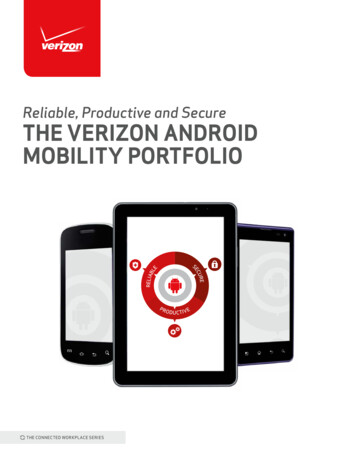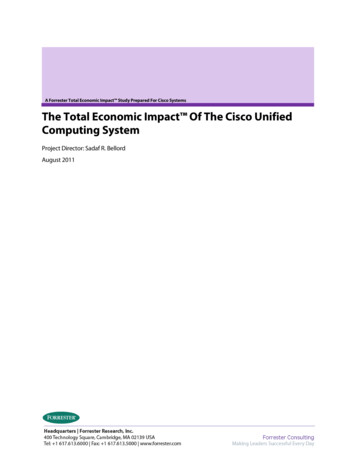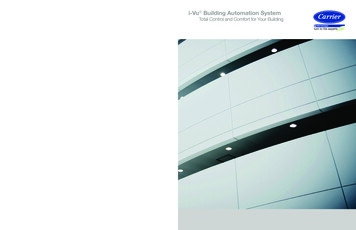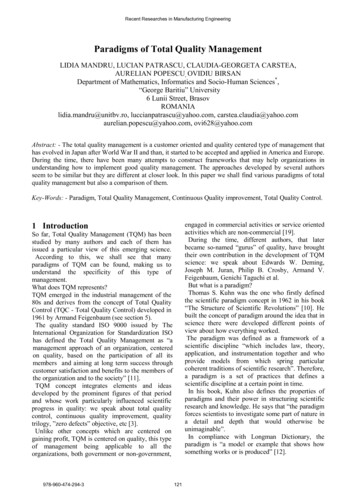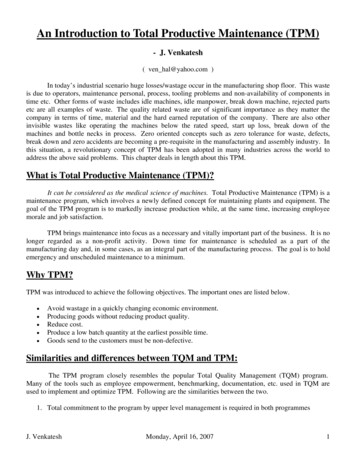
Transcription
An Introduction to Total Productive Maintenance (TPM)- J. Venkatesh( ven hal@yahoo.com )In today’s industrial scenario huge losses/wastage occur in the manufacturing shop floor. This wasteis due to operators, maintenance personal, process, tooling problems and non-availability of components intime etc. Other forms of waste includes idle machines, idle manpower, break down machine, rejected partsetc are all examples of waste. The quality related waste are of significant importance as they matter thecompany in terms of time, material and the hard earned reputation of the company. There are also otherinvisible wastes like operating the machines below the rated speed, start up loss, break down of themachines and bottle necks in process. Zero oriented concepts such as zero tolerance for waste, defects,break down and zero accidents are becoming a pre-requisite in the manufacturing and assembly industry. Inthis situation, a revolutionary concept of TPM has been adopted in many industries across the world toaddress the above said problems. This chapter deals in length about this TPM.What is Total Productive Maintenance (TPM)?It can be considered as the medical science of machines. Total Productive Maintenance (TPM) is amaintenance program, which involves a newly defined concept for maintaining plants and equipment. Thegoal of the TPM program is to markedly increase production while, at the same time, increasing employeemorale and job satisfaction.TPM brings maintenance into focus as a necessary and vitally important part of the business. It is nolonger regarded as a non-profit activity. Down time for maintenance is scheduled as a part of themanufacturing day and, in some cases, as an integral part of the manufacturing process. The goal is to holdemergency and unscheduled maintenance to a minimum.Why TPM?TPM was introduced to achieve the following objectives. The important ones are listed below. Avoid wastage in a quickly changing economic environment.Producing goods without reducing product quality.Reduce cost.Produce a low batch quantity at the earliest possible time.Goods send to the customers must be non-defective.Similarities and differences between TQM and TPM:The TPM program closely resembles the popular Total Quality Management (TQM) program.Many of the tools such as employee empowerment, benchmarking, documentation, etc. used in TQM areused to implement and optimize TPM. Following are the similarities between the two.1. Total commitment to the program by upper level management is required in both programmesJ. VenkateshMonday, April 16, 20071
2. Employees must be empowered to initiate corrective action, and3. A long-range outlook must be accepted as TPM may take a year or more to implement and is an ongoing process. Changes in employee mind-set toward their job responsibilities must take place aswell.The differences between TQM and TPM are summarized below.CategoryTQMTPMObjectQuality (Output and effects)Equipment (Input and cause)Mains of attaining goalSystematize the management. It is Employees participation and itsoftware orientedis hardware orientedTargetQuality for PPMEliminationwastes.oflossesandTypes of maintenance:1. Breakdown maintenance:In this type of maintenance, no care is taken for the machine, until equipment fails. Repair is thenundertaken. This type of maintenance could be used when the equipment failure does not significantlyaffect the operation or production or generate any significant loss other than repair cost. However, animportant aspect is that the failure of a component from a big machine may be injurious to the operator.Hence breakdown maintenance should be avoided.2. Preventive maintenance (1951):It is a daily maintenance (cleaning, inspection, oiling and re-tightening), design to retain the healthycondition of equipment and prevent failure through the prevention of deterioration, periodic inspection orequipment condition diagnosis, to measure deterioration. It is further divided into periodic maintenance andpredictive maintenance. Just like human life is extended by preventive medicine, the equipment service lifecan be prolonged by doing preventive maintenance.2a. Periodic maintenance (Time based maintenance - TBM):Time based maintenance consists of periodically inspecting, servicing and cleaningequipment and replacing parts to prevent sudden failure and process problems. E.g.Replacement of coolant or oil every 15 days.2b. Predictive maintenance:J. VenkateshMonday, April 16, 20072
This is a method in which the service life of important part is predicted based oninspection or diagnosis, in order to use the parts to the limit of their service life. Comparedto periodic maintenance, predictive maintenance is condition-based maintenance. It managestrend values, by measuring and analyzing data about deterioration and employs a surveillancesystem, designed to monitor conditions through an on-line system. E.g. Replacement ofcoolant or oil, if there is a change in colour. Change in colour indicates the deterioratingcondition of the oil. As this is a condition-based maintenance, the oil or coolant is replaced.3. Corrective maintenance (1957):It improves equipment and its components so that preventive maintenance can be carried outreliably. Equipment with design weakness must be redesigned to improve reliability or improvingmaintainability. This happens at the equipment user level. E.g. Installing a guard, to prevent the burrsfalling in the coolant tank.4. Maintenance prevention (1960):This program indicates the design of new equipment. Weakness of current machines is sufficientlystudied (on site information leading to failure prevention, easier maintenance and prevents of defects, safetyand ease of manufacturing). The observations and the study made are shared with the equipmentmanufacturer and necessary changes are made in the design of new machine.TPM - History:TPM is an innovative Japanese concept. The origin of TPM can be traced back to 1951 whenpreventive maintenance was introduced in Japan. However the concept of preventive maintenance was takenfrom USA. Nippondenso was the first company to introduce plant wide preventive maintenance in 1960.Preventive maintenance is the concept wherein, operators produced goods using machines and themaintenance group was dedicated with work of maintaining those machines, however with the automationof Nippondenso, maintenance became a problem, as more maintenance personnel were required. So themanagement decided that the operators would carry out the routine maintenance of equipment. (This isAutonomous maintenance, one of the features of TPM). Maintenance group took up only essentialmaintenance works.Thus Nippondenso, which already followed preventive maintenance, also added Autonomousmaintenance done by production operators. The maintenance crew went in the equipment modification forimproving reliability. The modifications were made or incorporated in new equipment. This lead tomaintenance prevention. Thus preventive maintenance along with Maintenance prevention andMaintainability Improvement gave birth to Productive maintenance. The aim of productive maintenancewas to maximize plant and equipment effectiveness.By then Nippon Denso had made quality circles, involving the employees participation. Thus allemployees took part in implementing Productive maintenance. Based on these developments Nippondensowas awarded the distinguished plant prize for developing and implementing TPM, by the Japanese Instituteof Plant Engineers (JIPE). Thus Nippondenso of the Toyota group became the first company to obtain theTPM certification.TPM Targets:J. VenkateshMonday, April 16, 20073
1.2.3.4.5.6.7.Obtain Minimum 90% OEE (Overall Equipment Effectiveness)Run the machines even during lunch. (Lunch is for operators and not for machines!)Operate in a manner, so that there are no customer complaints.Reduce the manufacturing cost by 30%.Achieve 100% success in delivering the goods as required by the customer.Maintain an accident free environment.Increase the suggestions from the workers/employees by 3 times. Develop Multi-skilled and flexibleworkers.Motives of TPMUniqueness of TPM1. Adoption of life cycle approach for improving the overallperformance of production equipment.2. Improving productivity by highly motivated workers, which isachieved by job enlargement.3. The use of voluntary small group activities for identifying thecause of failure, possible plant and equipment modifications.The major difference between TPM and other concepts is that theoperators are also made to involve in the maintenance process. Theconcept of "I (Production operators) Operate, You (Maintenancedepartment) fix" is not followed.TPM Objectives1. Achieve Zero Defects, Zero Breakdown and Zero accidents in allfunctional areas of the organization.2. Involve people in all levels of organization.3. Form different teams to reduce defects and self-Maintenance.Direct benefits of TPM1.2.3.4.Indirect benefits of TPM1.2.3.4.5.Increase in productivity and OEE (Overall Equipment Efficiency)Reduction in customer complaints.Reduction in the manufacturing cost by 30%.Satisfying the customers needs by 100 % (Delivering the rightquantity at the right time, in the required quality.)5. Reduced accidents.Higher confidence level among the employees.A clean, neat and attractive work place.Favourable change in the attitude of the operators.Achieve goals by working as team.Horizontal deployment of a new concept in all areas of theorganization.6. Sharing knowledge and experience.7. The workers get a feeling of owning the machine.OEE (Overall Equipment Efficiency):J. VenkateshMonday, April 16, 20074
The basic measure associated with Total Productive Maintenance (TPM) is the OEE. This OEEhighlights the actual "Hidden capacity" in an organization. OEE is not an exclusive measure of how wellthe maintenance department works. The design and installation of equipment as well as how it is operatedand maintained affect the OEE. It measures both efficiency (doing things right) and effectiveness (doing theright things) with the equipment. It incorporates three basic indicators of equipment performance andreliability. Thus OEE is a function of the three factors mentioned below.1. Availability or uptime (downtime: planned and unplanned, tool change, tool service, job change etc.)2. Performance efficiency (actual vs. design capacity)3. Rate of quality output (Defects and rework)Thus OEE A x PE x QA - Availability of the machine. Availability is proportion of time machine is actually available out of timeit should be available.Availability (Planned production time – unscheduled downtime)Planned production timeProduction time Planned production time – DowntimeGross available hours for production include 365 days per year, 24 hours per day, 7 days per week.However this is an ideal condition. Planned downtime includes vacation, holidays, and not enough loads.Availability losses include equipment failures and changeovers indicating situations when the line is notrunning although it is expected to run.PE - Performance Efficiency. The second category of OEE is performance. The formula can be expressedin this way:J. VenkateshMonday, April 16, 20075
Performance (Speed) (Cycle time x Number of products processed)Production timeNet production time is the time during which the products are actually produced. Speed losses, small stops,idling, and empty positions in the line indicate that the line is running, but it is not providing the quantity itshould.Q - Refers to quality rate. Which is percentage of good parts out of total produced. Sometimes called“yield”. Quality losses refer to the situation when the line is producing, but there are quality losses due toin-progress production and warm up rejects. We can express a formula for quality like this:Quality (Yield) (Number of products processed – Number of products rejected)(Number of products processed)A simple example on how OEE is calculated is shown below. Running 70 percent of the time (in a 24-hour day)Operating at 72 percent of design capacity (flow, cycles, units per hour)Producing quality output 99 percent of the timeWhen the three factors are considered together (70% availability x 72% efficiency x 99% quality), theresult is an overall equipment effectiveness rating of 49.9 percent.Stages in TPM implementation:Step A - PREPARATORY STAGE:STEP 1 - Announcement by Management to all about TPM introduction in the organization:Proper understanding, commitment and active involvement of the top management inneeded for this step. Senior management should have awareness programmes, after whichannouncement is made. Decision the implement TPM is published in the in house magazine,displayed on the notice boards and a letter informing the same is send to suppliers andcustomers.STEP 2 - Initial education and propaganda for TPM:Training is to be done based on the need. Some need intensive training and some justawareness training based on the knowledge of employees in maintenance.STEP 3 - Setting up TPM and departmental committees:TPM includes improvement, autonomous maintenance, quality maintenance etc., aspart of it. When committees are set up it should take care of all those needs.STEP 4 - Establishing the TPM working system and target:Each area/work station is benchmarked and target is fixed up for achievement.J. VenkateshMonday, April 16, 20076
STEP 5 - A master plan for institutionalizing:Next step is implementation leading to institutionalizing wherein TPM becomes anorganizational culture. Achieving PM award is the proof of reaching a satisfactory level.STEP B - INTRODUCTION STAGEA small get-together, which includes our suppliers and customer’s participation, is conducted.Suppliers as they should know that we want quality supply from them. People from related companies andaffiliated companies who can be our customers, sisters concerns etc. are also invited. Some may learn fromu
TPM is an innovative Japanese concept. The origin of TPM can be traced back to 1951 when preventive maintenance was introduced in Japan. However the concept of preventive maintenance was taken from USA. Nippondenso was the first company to introduce plant wide preventive maintenance in 1960. Preventive maintenance is the concept wherein, operators produced goods using machines and the .

